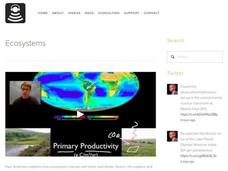Amoeba Sisters
Biomagnification and the Trouble with Toxins
Explore biomagnification which can happen when toxins become more highly concentrated when moving up through trophic levels in the food chain. Uncontrolled use of DDT is used in video as an example. Learn why bioaccumulation can occur in...
Be Smart
The Invisible Creatures That Keep You Alive!
A complete microbiome lives inside us, and believe it or not, that's a good thing.
Crash Course Kids
Food Chains Compilation
Maybe you'd like to just hear about one topic for a while. We understand. So today, let's just watch some videos about how we get energy. And how one animal gets energy from another animal, or a plant. It's all about food chains and food...
Be Smart
The Surprising Origin of Thanksgiving Foods
Ever wonder where your favorite Thanksgiving foods come from? Well the truth may be closer to home than you think.
Crash Course Kids
Home Sweet Habitat: Crash Course Kids
How would a Polar Bear do if you put it in the desert? Not well. But why? Why can't anything live anywhere? Well, this has to do with Habitats and how animals (including humans) are suited for living in one place over another. In this...
Visual Learning Systems
Summing Up
New ReviewIn this video students will learn how living things and nonliving things interact in ecosystems. Specific attention is given to identifying producers, consumers and decomposers. Vivid, live-action video shows these relationships in...
Curated Video
Food chains – What happens next?
Leaves fall to the forest floor ... but what happens next?
Life processes - Living things in their environments - Food chains
A Twig Tidbit Film - What happens next? A short section of film is played and the children have to...
Wonderscape
The Cycle of Life: Matter and Energy in Ecosystems Review
Review the critical concepts of how matter and energy interact in natural systems. This video summarizes the energy processes in organisms and ecosystems, highlighting photosynthesis in plants, energy transfer through food consumption,...
Curated Video
What is an Ecosystem?
An ecosystem is a complete community of living organisms and the nonliving materials of their surroundings. This includes plants, animals, microorganisms and their environment, such as soil, rocks, and minerals. An Ecosystem also...
Curated Video
GCSE Biology - Trophic Levels - Producers, Consumers, Herbivores & Carnivores #86
This video covers:
- The idea that trophic levels are just the different levels of a food chain
- Trophic level 1 are called the producers
- Trophic level 2 are primary consumers, trophic level 3 are called the secondary consumers and...
Curated Video
GCSE Biology - Food Chains & Predator Prey Cycles #85
For ecosystems to function they need energy; and we can see how this energy moves through ecosystems with food chains. We also explore how the populations of predators and prey vary over time with predator prey cycles.
Curated Video
Animals Depend on Plants
Animals Depend on Plants describes why animal production is dependent on plant production in an ecosystem
Curated Video
What are Food Chains | Learning Science
Where do plants and animals get their energy from? Explore food chains and see how energy is passed from the sun to plants and on to first, second and third order consumers.
Curated Video
Microorganisms
Microorganisms | Genetics | Biology | FuseSchool
Would you be surprised to hear that over 60% of life on earth is so small that it can only be seen with a microscope? We call all of these little things ‘microbes’ or...
Curated Video
Nutrition and Energy Flow Part 1
In this section, I talk about the sun as a source of energy, consumers vs. producers and cycles found in nature
PBS
Why Do We Eat Popcorn at The Movies?
Why do we eat popcorn at the movies? And what does the Great Depression and farm subsidies have to do with it?
Visual Learning Systems
Food Chains: Video Review
It is fascinating to explore the energy relationships between living things. This exciting video investigates the process of living things producing energy, consuming it, and breaking it down. Food chains and food webs visually...
Bozeman Science
Ecosystems
Living and non-living things are both a part of an ecosystem. A video begins with ecosystem interactions using biotic and abiotic factors. It also covers food webs, limiting factors, and logistic growth. As a real-world connection, it...
TED-Ed
Dead Stuff: The Secret Ingredient in Our Food Chain
A disgusting and direct description of detritus and decomposition is digested in this drill! Your life science class learns about the importance of decomposers in the food chain and finds out how one organism's trash is another...
Curated OER
Biotic and Abiotic Factors
Life is complex. Just a slight change in the population of one species will have a substantial change on the biotic and abiotic factors of that species' environment. In this video, Mr. Andersen explains the effects removing wolves from...
Curated OER
Coral Reef Ecosystem
The coral reef ecosystem is abundant and lively. Dive in for an underwater view of the species living there. Polyps, urchin, barracudas, and eels (among others) exist in part because of the sun's presence in this ecosystem. Use this as...
Scholastic
Study Jams! Ecosystems
With the forest as an example, Sam and Zoe talk about the components biotic and abiotic of an ecosystem. They also discuss the role of producers, consumers, and decomposers. This concise clip covers all of the basics. As an introduction...
Scholastic
Study Jams! Food Webs
Rhinozilla is back to take your lesson plan on trophic levels a step higher! After showing the video on food chains (available through the See All Related Jams button), add to it by showing this one. It deals with omnivores and food...






